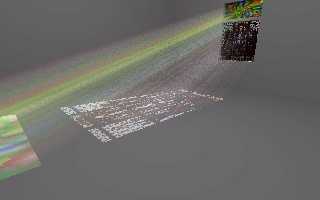I solved the missing color problem and will attach the related
code to the end of this message for those who wish to learn from
my mistakes er I mean efforts.
The first observation I have related to the process is make sure you
choose an image that has a low color count and nice bright colors.
Images with sharp contrasts from light to dark in small areas work
poorly. Images with small numbers of uniformly shaded areas work the
best. I believe the reason for this has to do with the way each
color, as it is projected through the media, reacts and scatters
to adjacent paths. If you have too many colors the color information
is lost as it is scattered and mixed with the colors right next to it.
The finer the media particle size you use the less this will occur.
It also adds lifetimes to the render time of the scene.
The example image below show two sections. One is a .png image
I used with the last post that was color corrected to work better
with this last attempt. It still was a poor choice of images and
I know what to look for next time. The top section I added to show
the difference between using an image map and a standered filtered
pigment. The difference is quite noticable and shows that a pigment
related process probably offers the greatest control of the two
methods. One or two renders really is not a fair comparison so
feel free to experiment and decide for your self which works the
best. If you don't like the way I write my code feel free to delete
it from your system. I won't cry or lose any sleep over it.
Cheers,
--
Ken Tyler
mailto://tylereng@pacbell.net
Post a reply to this message
Attachments:
Download 'imapmdia.jpg' (17 KB)
Download 'imapmdia.pov.txt' (5 KB)
Preview of image 'imapmdia.jpg'

|




![]()